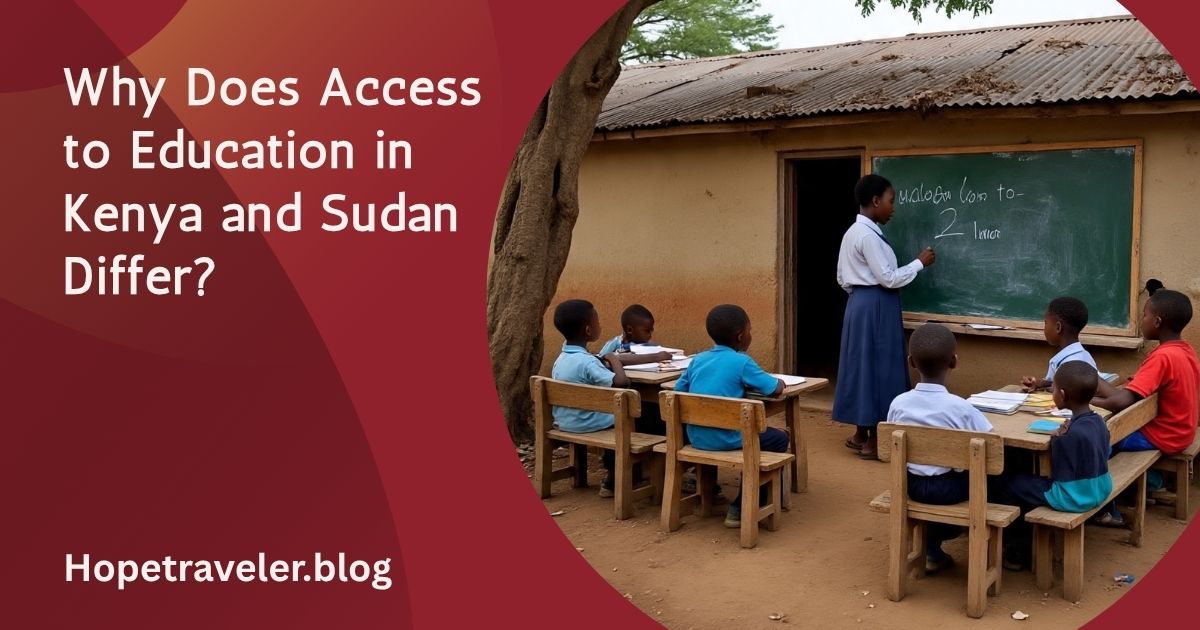Education is widely regarded as a fundamental human right and a catalyst for economic and social development. However, access to education is not uniform across all regions, especially in developing nations. A glaring example of this inequality exists between two African countries — Kenya and Sudan. While both nations share geographic proximity and some cultural similarities, the educational systems and access levels differ significantly. This article explores why access to education in Kenya and Sudan differs, examining key historical, political, economic, and social factors that have shaped their distinct educational trajectories.
Historical Context
Kenya’s Colonial Legacy and Early Investments
Kenya, formerly a British colony, inherited an education system modeled after the British curriculum. Post-independence in 1963, the Kenyan government prioritized expanding education, especially primary education. National policies like the Free Primary Education (FPE) policy introduced in 2003 helped increase enrollment rates and reduce illiteracy. According to Wikipedia’s article on Education in Kenya, the literacy rate among youths is over 85%, and primary school enrollment is relatively high compared to neighboring countries.
Sudan’s Historical Conflicts and Neglect
Sudan, on the other hand, has experienced extended periods of civil unrest, particularly the First (1955–1972) and Second Sudanese Civil Wars (1983–2005). These conflicts disrupted education systems and destroyed infrastructure. After the secession of South Sudan in 2011, Sudan was left to rebuild, but political instability continues to hinder progress. Education in Sudan, according to Wikipedia, suffers from underfunding, regional disparities, and low retention rates.
Political Stability and Governance
Kenya’s Democratic Structures and Policies
Despite some political turbulence, Kenya has a more stable and democratic government, which facilitates long-term planning and policy implementation. The Ministry of Education in Kenya has developed progressive plans such as Vision 2030, which emphasizes inclusive education and skill development. Stable governance enables regular funding, teacher training, and curriculum development.
Sudan’s Political Instability and Military Rule
Sudan’s political landscape has been dominated by coups, authoritarian regimes, and civil wars. The frequent power transitions and absence of democratic structures have made consistent education reform nearly impossible. The military-led government often diverts national funds to security rather than social services like education.
Economic Disparities
Kenya’s Economic Growth and Investment in Education
Kenya is classified as a lower-middle-income country by the World Bank. Its relatively stronger economy has enabled greater investment in public services, including education. The Education in Kenya system receives a significant portion of the national budget, facilitating programs such as school feeding, free textbooks, and school infrastructure projects.
Sudan’s Economic Crisis and Underfunding
Sudan has struggled with economic sanctions, loss of oil revenues after South Sudan’s independence, and hyperinflation. These economic challenges severely limit public expenditure on education. According to Wikipedia, schools in Sudan often lack basic infrastructure, trained teachers, and materials. Many children drop out of school due to poverty, particularly in rural areas.
Gender and Cultural Barriers
Kenya’s Progress on Gender Parity
Kenya has made noticeable progress in reducing gender disparities in education. Policies promoting girl-child education and efforts by NGOs have increased female enrollment rates. School-based gender violence and teenage pregnancies still exist, but public awareness and interventions are more robust.
Sudan’s Gender Inequality in Education
In Sudan, especially in rural and conflict-affected areas, cultural norms and early marriage significantly hinder girls’ education. According to UNESCO data, female literacy and school completion rates are much lower compared to males. Social expectations often prioritize domestic roles for girls, and parents are less likely to invest in their daughters’ education.
Infrastructure and Technology
Kenya’s Use of Digital Tools and Better Facilities
Kenya has embraced digital learning tools and launched initiatives like the Digital Literacy Programme to enhance technology in education. Many schools have computer labs, electricity, and internet access, particularly in urban areas.
Sudan’s Lack of Infrastructure
In Sudan, many schools operate in temporary shelters without electricity, clean water, or toilets. This lack of basic facilities discourages attendance and learning. Furthermore, conflict has destroyed many schools, and rebuilding efforts are slow or non-existent in some regions.
Role of International Aid and NGOs
Kenya: Strategic Partnerships
Kenya benefits from extensive international aid for education from partners like USAID, UNICEF, and the World Bank. These collaborations help train teachers, build schools, and provide learning materials. In addition, Kenya’s relatively better governance structure allows for efficient use of funds.
Sudan: Limited and Risky Aid Environment
In Sudan, the delivery of foreign aid is complicated due to insecurity and political volatility. Aid agencies often face bureaucratic hurdles, safety issues, and restricted access to remote or conflict-ridden areas. This severely limits the impact of foreign assistance on education development.
Regional Disparities Within the Countries
Kenya’s Uneven Development
Although Kenya performs better overall, disparities still exist between urban and rural areas, as well as among counties. Some northern and arid regions experience teacher shortages and poor infrastructure, similar to the national average in Sudan.
Sudan’s Fragmented Educational Access
The situation is far more severe in Sudan, where entire provinces suffer from non-existent education services due to conflict or neglect. Marginalized regions like Darfur and the Nuba Mountains face chronic educational exclusion.
Language and Curriculum Challenges
Kenya’s Bilingual Curriculum Approach
Kenya uses both English and Kiswahili as languages of instruction. This dual-language policy improves accessibility and national integration. Efforts are being made to incorporate indigenous languages at lower levels of education, improving comprehension among young learners.
Sudan’s Arabic-Dominated System
Sudan’s education system is primarily in Arabic, which creates a barrier for ethnic minorities who do not speak the language. This leads to lower participation and poor performance among non-Arabic-speaking communities.
Conclusion
The difference in access to education between Kenya and Sudan is influenced by a combination of historical, political, economic, and social factors. Kenya’s relative political stability, economic growth, international partnerships, and gender-focused reforms have helped create a more inclusive education system. In contrast, Sudan’s prolonged conflicts, weak governance, underinvestment, and cultural constraints have limited educational access for large segments of the population, especially girls and rural communities.
Bridging the gap requires sustained peace, democratic governance, targeted investments, and international support. Sudan can potentially learn from Kenya’s policies and partnerships to reconstruct its education system. Ultimately, ensuring equitable access to education is essential for national development, peace, and prosperity in both nations.




